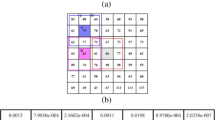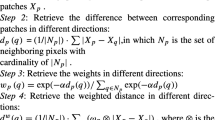Abstract
In recent years, benefiting from the abilities in implementation of the smooth operation on noises and preservation of the original gradient information on the texture edges, the guided filter (GF)-based fuzzy clustering has achieved inspiring performance in the task of image segmentation. However, different to image pixels, the general data samples do not have the spatial adjacency relations. Current GF-based methods suffer some limitations in general data clustering. To solve this issue, a series of improved GF-based fuzzy clustering algorithms are proposed in this paper for general data analysis. In the most basic algorithm, a new data filtering window is first defined according to the neighbor relationships between data samples, and a pruning mechanism is designed to ensure the symmetry of neighbor samples. Then, the GF-based Fuzzy C-Means algorithm is put forward for the general data clustering. In addition, a weighted version is presented to process high-dimensional data, in which each dimension is assigned a weight, and the entropy regularization method is applied to optimize the weight assignment and highlight the important dimensions on both filtering and clustering. Furthermore, the kernelization of the above methods are realized for the non-linear data. Experimental results on synthetic and real-world datasets demonstrate better performance of the proposed methods in comparison with some existing FCM-type clustering approaches.




Similar content being viewed by others
References
Mirzal, A.: Statistical analysis of microarray data clustering using NMF, spectral clustering, Kmeans, and GMM. IEEE/ACM Trans. Comput. Biol. Bioinfo. (2020)
Deng, X., Chen, J., Li, H., Han, P., Yang, W.: Log-cumulants of the finite mixture model and their application to statistical analysis of fully polarimetric UAVSAR data. Geo-Spatial Inf. Sci. 21(1), 45–55 (2018)
Ryu, H..c, Jung, S., Pramanik, S.: An Effective Clustering Method over CF \(\$\hat{+}\$+\) Tree Using Multiple Range Queries. IEEE Trans. Knowl. Data Eng. 32(9), 1694–1706 (2019)
Wu, J., Long, K., Wang, F., Qian, C., Li, C., Lin, Z., Zha, H.: Deep comprehensive correlation mining for image clustering. In: Proceedings of the IEEE/CVF International Conference on Computer Vision, pp. 8150–8159 (2019)
Ji, X., Henriques, J.F., Vedaldi, A.: Invariant information clustering for unsupervised image classification and segmentation. In: Proceedings of the IEEE/CVF International Conference on Computer Vision, pp. 9865–9874 (2019)
Kim, W., Kanezaki, A., Tanaka, M.: Unsupervised learning of image segmentation based on differentiable feature clustering. IEEE Trans. Image Process. 29, 8055–8068 (2020)
Bezdek, J.C., Ehrlich, R., Full, W.: FCM: The fuzzy c-means clustering algorithm. Comput. Geosci. 10(2–3), 191–203 (1984)
Deng, Z., Choi, K.S., Jiang, Y., Wang, J., Wang, S.: A survey on soft subspace clustering. Inf. Sci. 348, 84–106 (2016)
Tao, Z., Li, J., Fu, H., Kong, Y., Fu, Y.: From ensemble clustering to subspace clustering: cluster structure encoding. IEEE Transactions on Neural Networks and Learning Systems (2021)
Zhou, J., Chen, L., Chen, C.P., Zhang, Y., Li, H.X.: Fuzzy clustering with the entropy of attribute weights. Neurocomputing 198, 125–134 (2016)
Guo, Y., Wang, R., Zhou, J., Chen, Y., Jiang, H., Han, S., Wang, L., Du, T., Ji, K., Zhao, Y.o.: Soft subspace fuzzy clustering with dimension affinity constraint. Int. J. Fuzzy Syst. 1–19 (2022)
Graves, D., Pedrycz, W.: Kernel-based fuzzy clustering and fuzzy clustering: a comparative experimental study. Fuzzy Sets Syst. 161(4), 522–543 (2010)
Wang, Y., Dong, J., Zhou, J., Xu, G., Chen, Y.: Random feature map-based multiple kernel fuzzy clustering with all feature weights. Int. J. Fuzzy Syst. 21(7), 2132–2146 (2019)
Zeng, S., Wang, X., Duan, X., Zeng, S., Xiao, Z., Feng, D.: Kernelized mahalanobis distance for fuzzy clustering. IEEE Trans. Fuzzy Syst. 29(10), 3103–3117 (2020)
Liu, J., Li, M., Wang, J., Wu, F., Liu, T., Pan, Y.: A survey of MRI-based brain tumor segmentation methods. Tsinghua Sci. Technol. 19(6), 578–595 (2014)
Ahmed, M.N., Yamany, S.M., Mohamed, N., Farag, A.A., Moriarty, T.: A modified fuzzy c-means algorithm for bias field estimation and segmentation of MRI data. IEEE Trans. Med. Imaging 21(3), 193–199 (2002)
Krinidis, S., Chatzis, V.: A robust fuzzy local information C-means clustering algorithm. IEEE Trans. Image Process. 19(5), 1328–1337 (2010)
Wei, T., Wang, X., Li, X., Zhu, S.: Fuzzy subspace clustering noisy image segmentation algorithm with adaptive local variance & non-local information and mean membership linking. Eng. App. Artif. Intel. 110, 104672 (2022)
Yang, Y., Wu, C., Li, Y., Zhang, S.: Robust semisupervised kernelized fuzzy local information C-means clustering for image segmentation. Mathematical Problems in Engineering 2020 (2020)
Mian Qaisar, S., Hammad, N., Khan, R.: A combination of DWT CLAHE and Wiener filter for effective scene to text conversion and pronunciation. J. Electr. Eng. Technol. 15(4), 1829–1836 (2020)
Zhang, H., Li, H., Chen, N., Chen, S., Liu, J.: Novel fuzzy clustering algorithm with variable multi-pixel fitting spatial information for image segmentation. Pattern Recogn. 121, 108201 (2022)
He, K., Sun, J., Tang, X.: Guided image filtering. IEEE Trans. Pattern Analys. Mach. Intel. 35(6), 1397–1409 (2012)
Guo, L., Chen, L., Wu, Y., Chen, C.L.: Image guided fuzzy c-means for image segmentation. Int. J. Fuzzy Syst. 19(6), 1660–1669 (2017)
Guo, L., Chen, L., Chen, C.P., Zhou, J.: Integrating guided filter into fuzzy clustering for noisy image segmentation. Digital Signal Process. 83, 235–248 (2018)
Xu, G., Zhou, J., Dong, J., Chen, C.L., Zhang, T., Chen, L., Han, S., Wang, L., Chen, Y.: Multivariate morphological reconstruction based fuzzy clustering with a weighting multi-channel guided image filter for color image segmentation. Int. J. Mach. Learn. Cybern. 11(12), 2793–2806 (2020)
Qiao, C., Wu, C., Wang, J.: Robust fuzzy clustering algorithms integrating membership guided image filtering. Signal Image Video Process. 16, 1–9 (2022)
Qiao, C., Wu, C., Li, C., Wang, J.: Guided filter-driven kernel fuzzy clustering with local information for noise image segmentation. Multimedia Tools App 1–47 (2022)
Funding
This work was funded in part by the National Natural Science Foundation of China under Grants with No.62273164, No. 61873324, and No. 61903156, the Natural Science Foundation of Shandong Province under Grant with No. ZR2019MF040, the Higher Educational Science and Technology Program of Jinan City under Grant with No. 2020GXRC057.
Author information
Authors and Affiliations
Corresponding authors
Appendix
Appendix
In this appendix, we prove that the filtered fuzzy memberships still retain the constraint \(\sum _{i=1}^C u_{ij}' = 1\) which is equivalent to
By using the general multi-channel guided filtering formula to carry out the backward calculation, we have
As the sum of a data sample’s fuzzy membership degrees is constant 1, i.e., \(\sum _{i=1}^{C}u_{ij}=1\), we obtain
We substitute (40) into (39) and then arrive at
Considering that the guidance data \(x_{jm}\) and the mean value \(\mu _{km}\) are irrelevant to the cluster, we have
Finally, bu substituting (42) into (41), we obtain
The above formula proves that the membership degrees still retains its inherent property after general guided filtering. In other words, the sum of filtered membership degrees of each data point belonging to all clusters is still 1.
Rights and permissions
Springer Nature or its licensor (e.g. a society or other partner) holds exclusive rights to this article under a publishing agreement with the author(s) or other rightsholder(s); author self-archiving of the accepted manuscript version of this article is solely governed by the terms of such publishing agreement and applicable law.
About this article
Cite this article
Wang, Y., Qin, Q., Zhou, J. et al. Guided Filter-Based Fuzzy Clustering for General Data Analysis. Int. J. Fuzzy Syst. 25, 2036–2051 (2023). https://doi.org/10.1007/s40815-023-01490-5
Received:
Revised:
Accepted:
Published:
Issue Date:
DOI: https://doi.org/10.1007/s40815-023-01490-5




